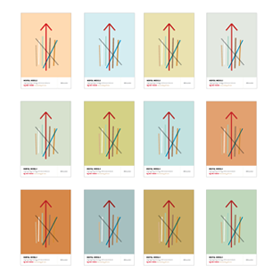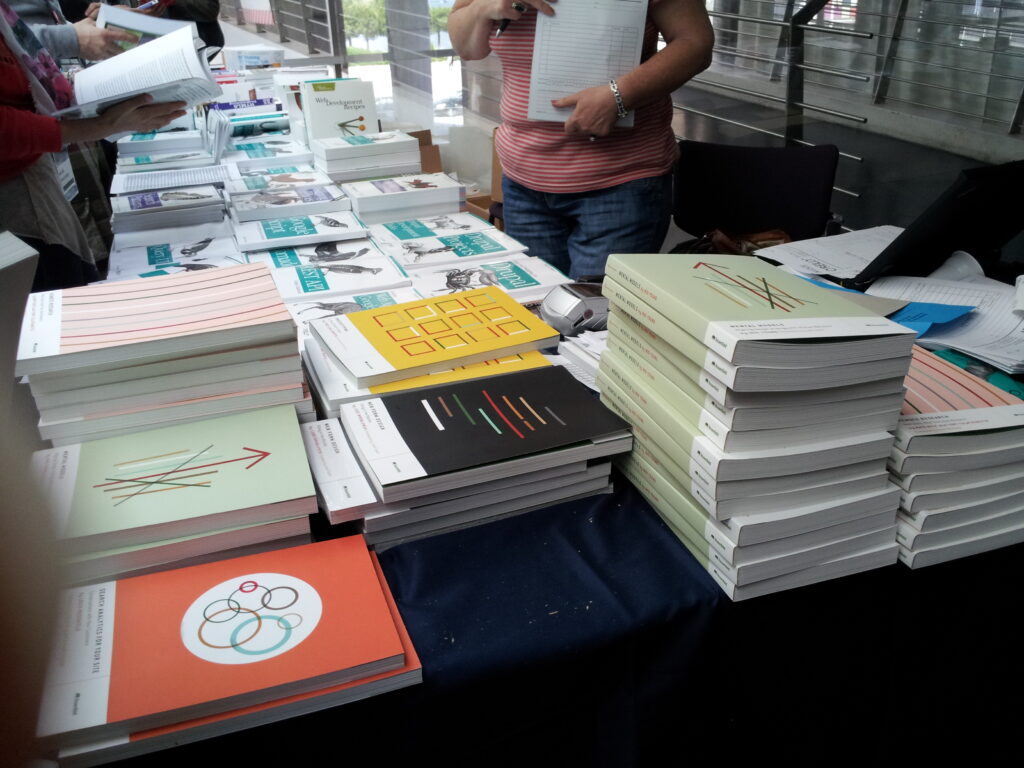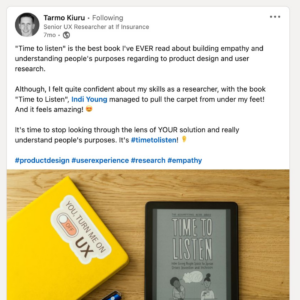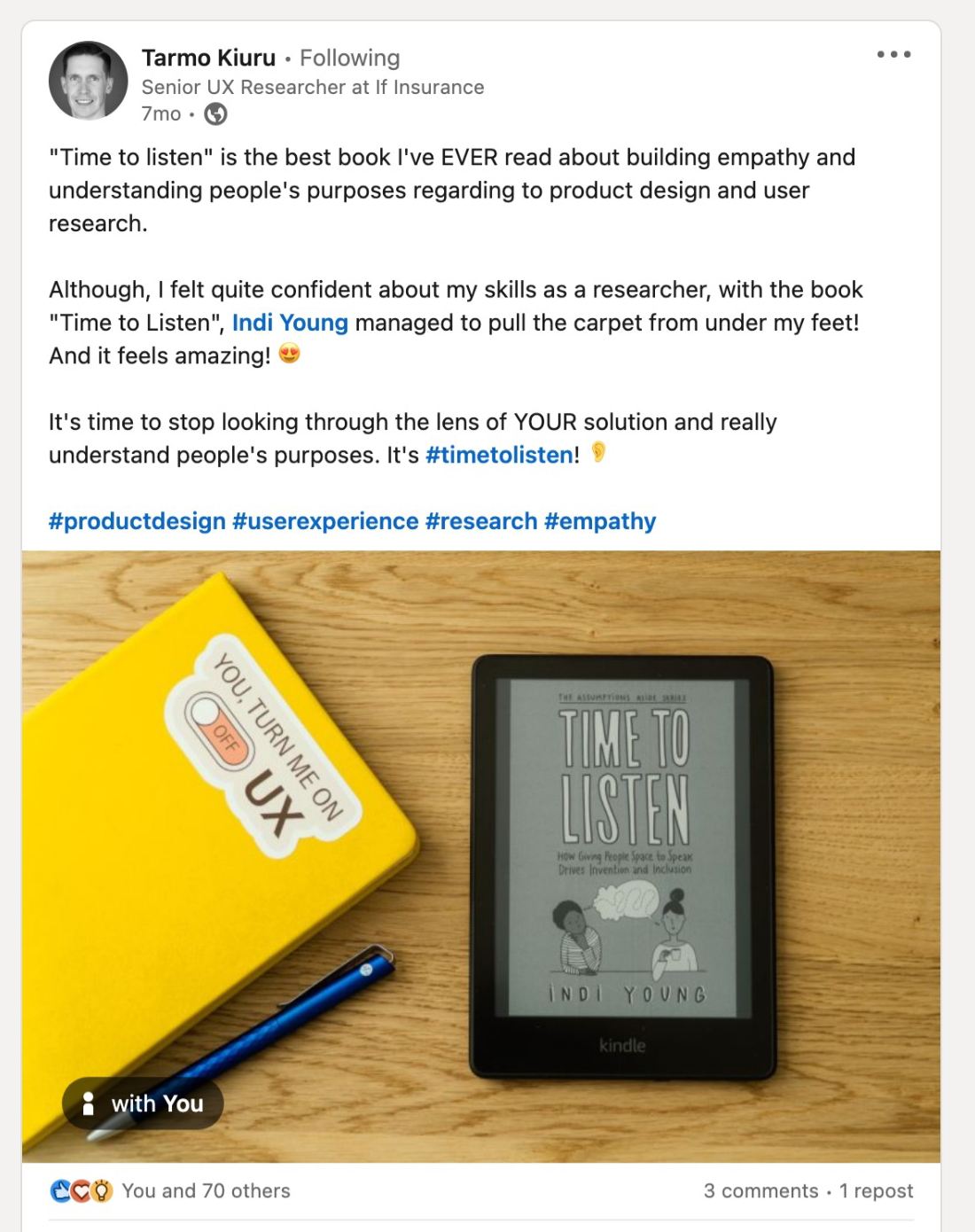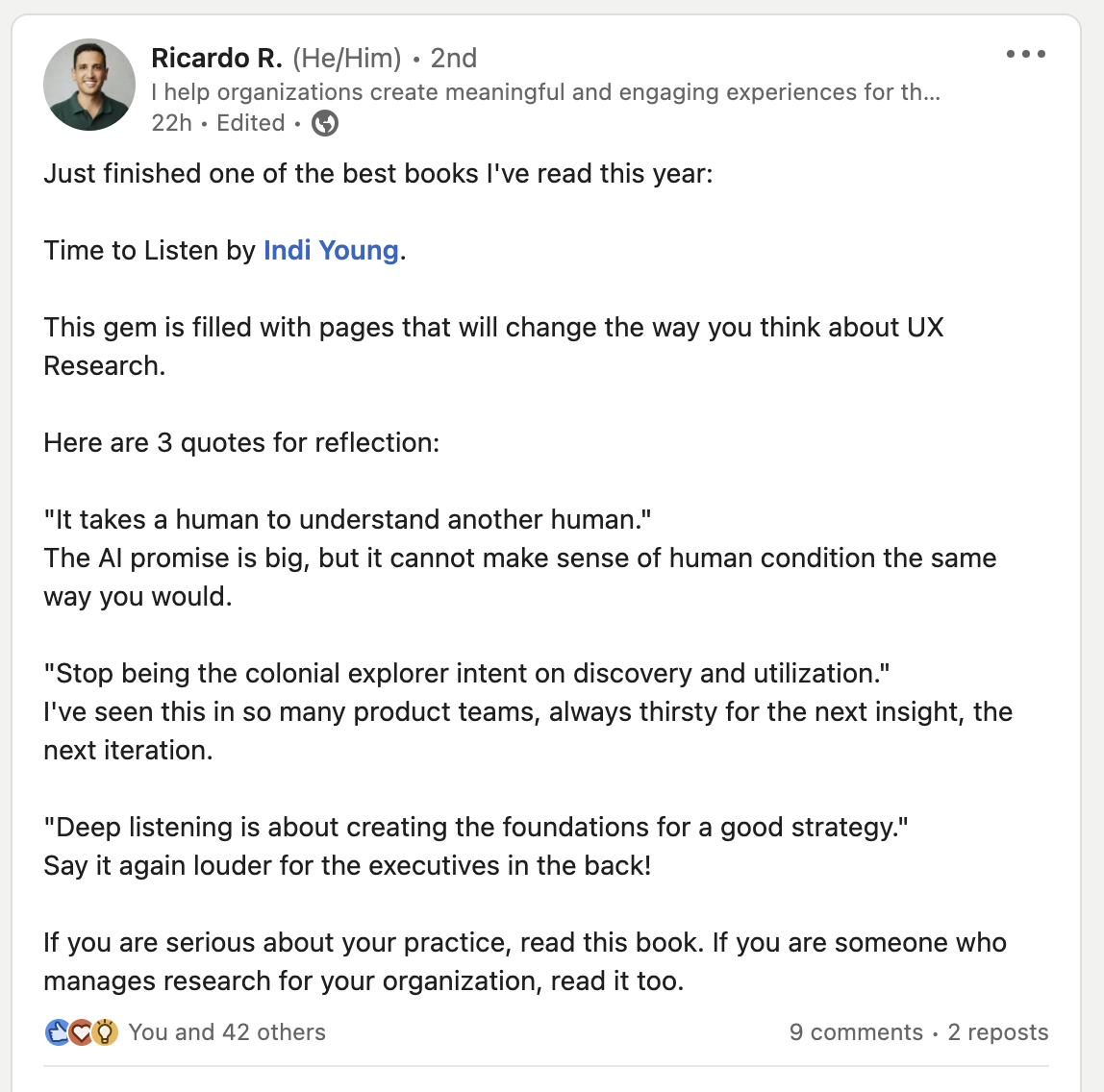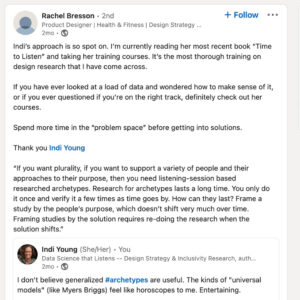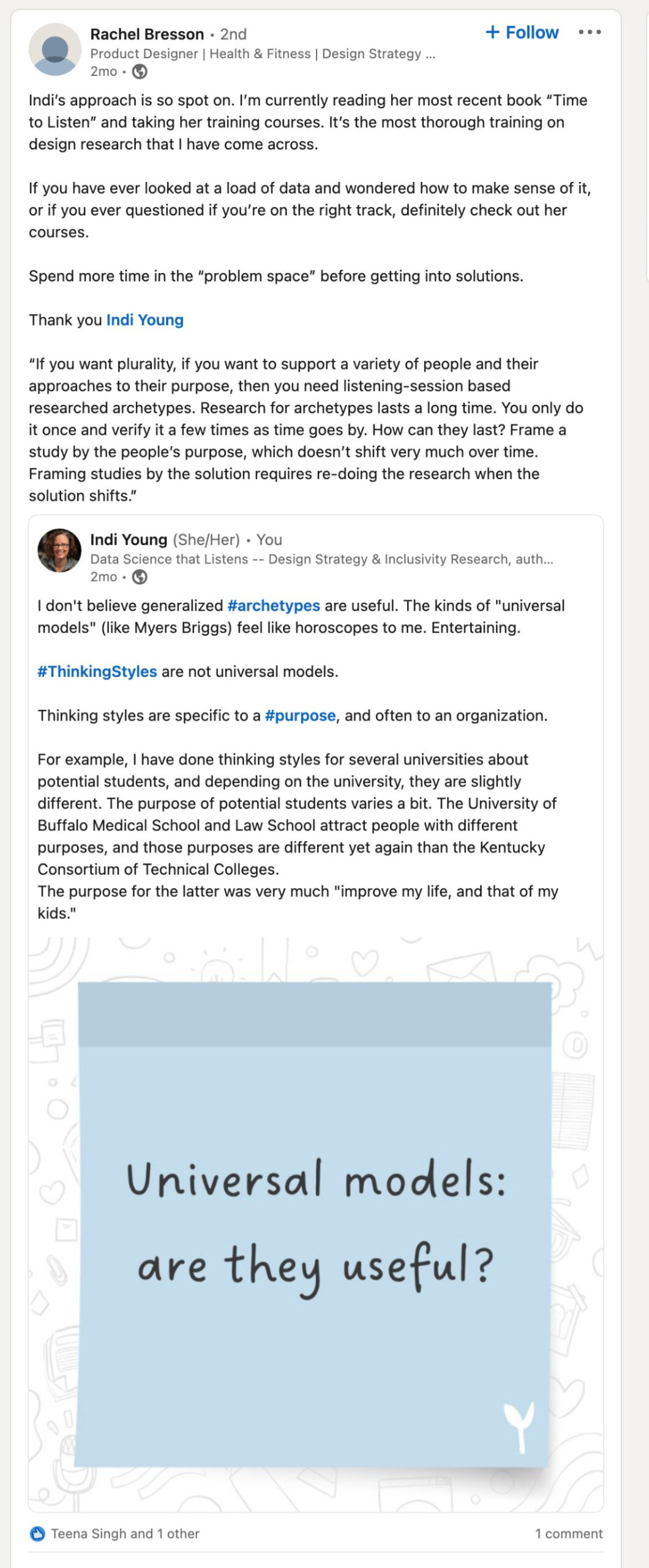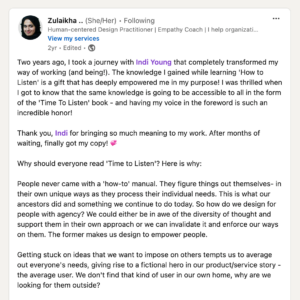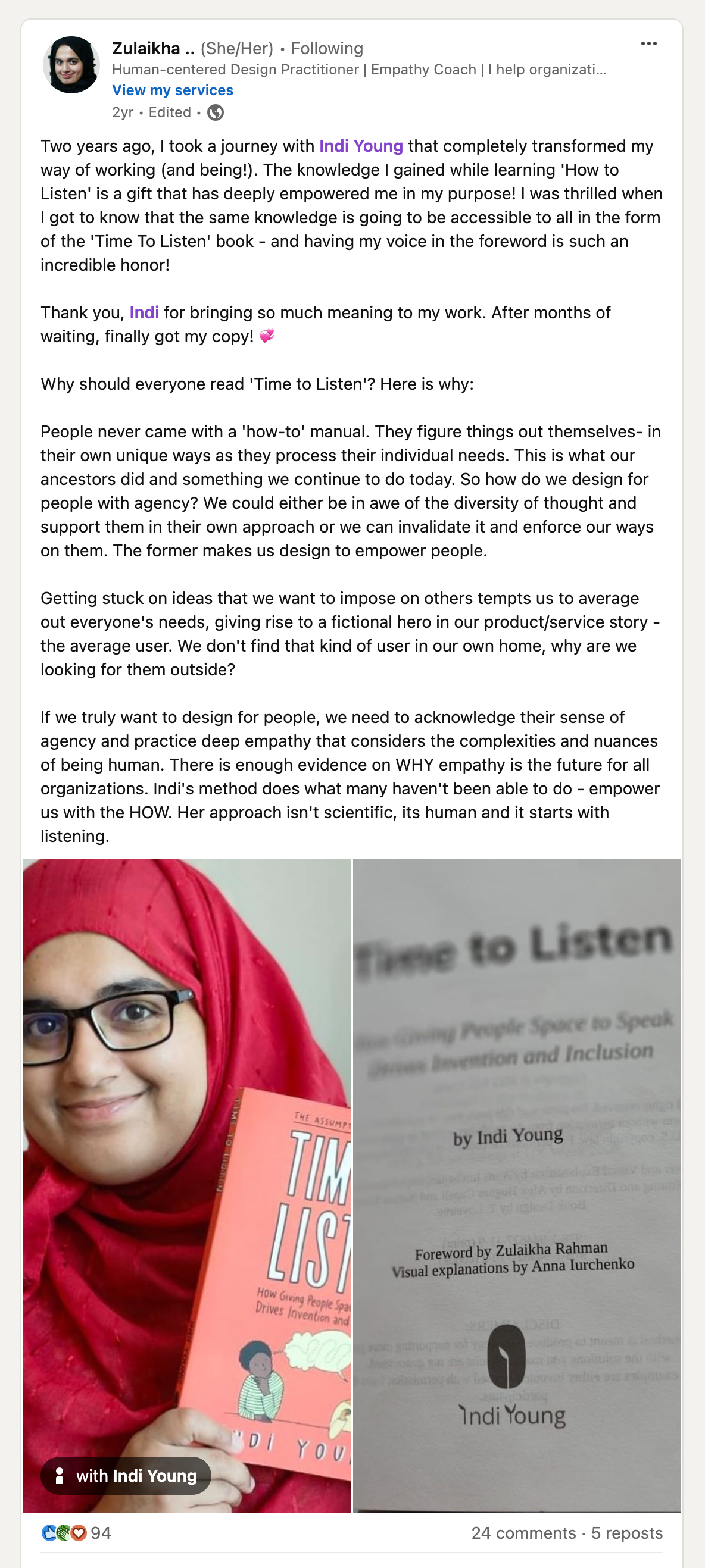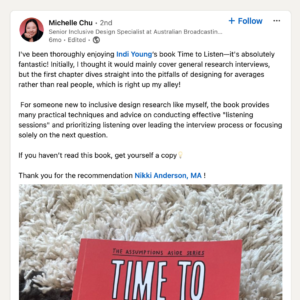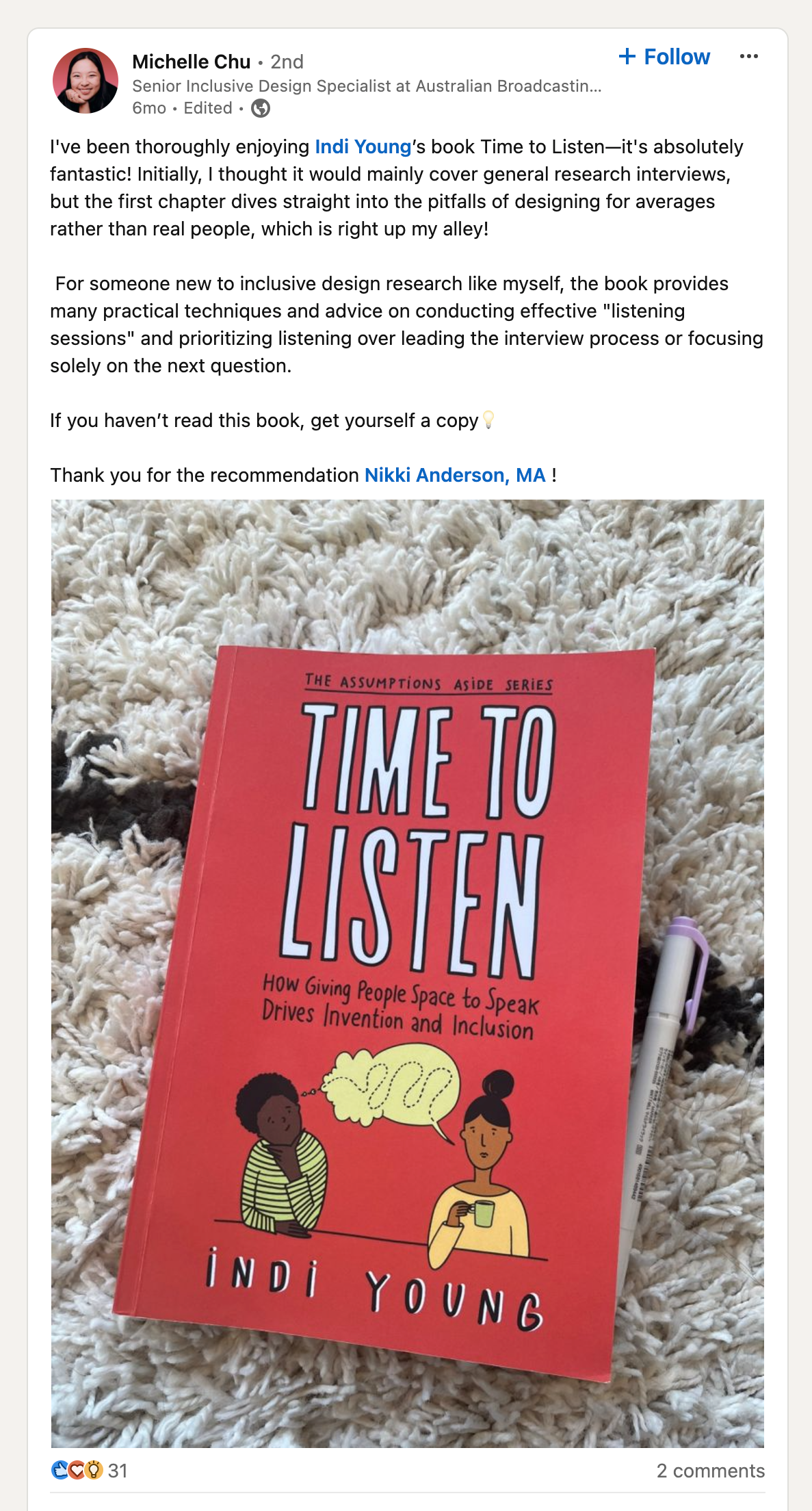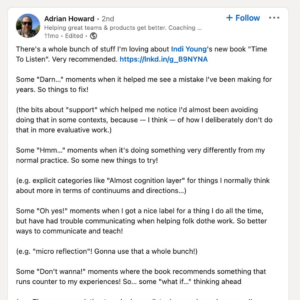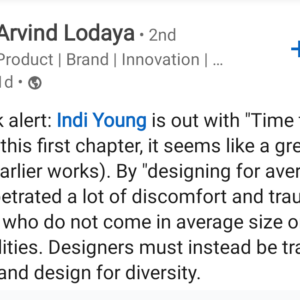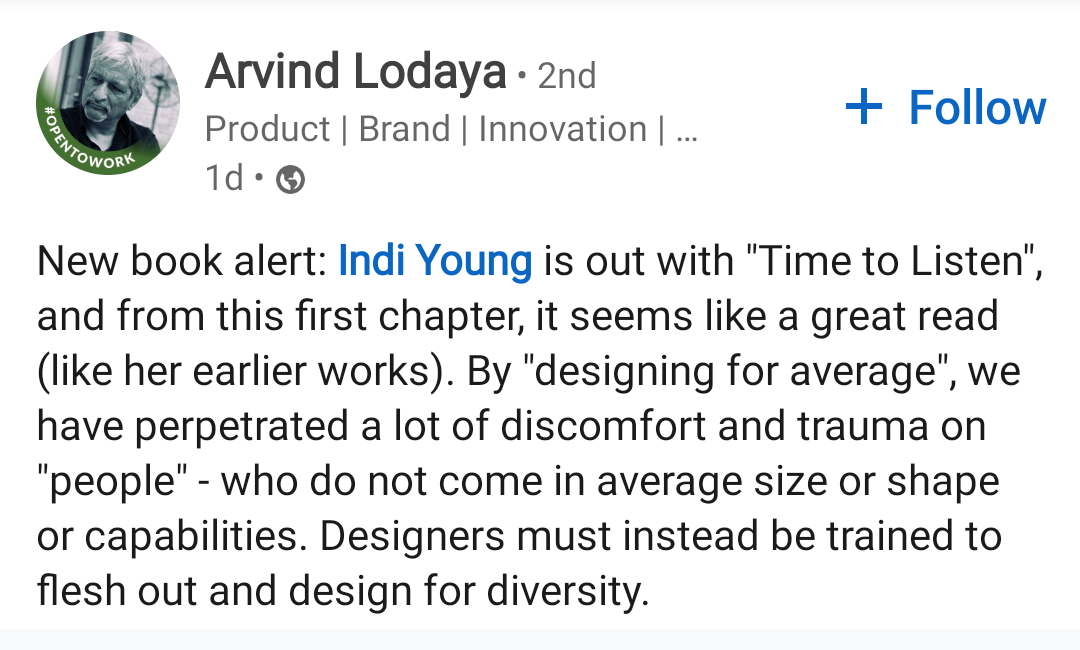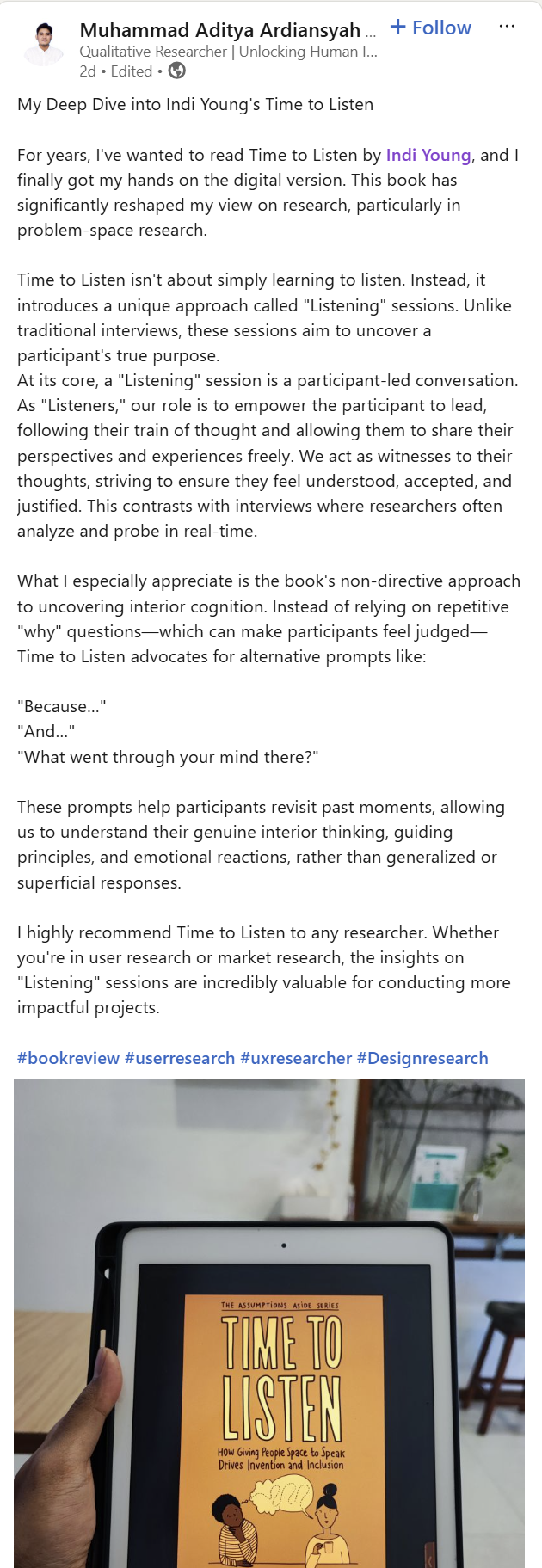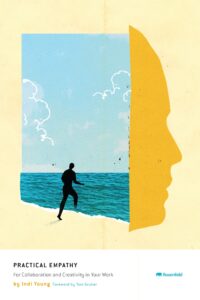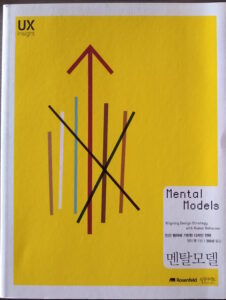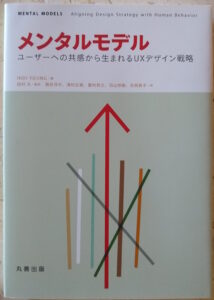Books by Indi Young
2022: Time to Listen – Many people have left toxic orgs to make space to
actually support people with solutions that match their interior cognition. This
book shows you how to start, by making time to listen.
2015: Practical Empathy – The meme of empathy with users was just taking off as we titled this book. Empathy is about true listening, not assumptions or imagination. Solid knowledge for product ideas. (Indi recorded the audiobook, too!)
2008: Mental Models – Indi’s first book about mental model skylines, thinking styles, and how to create them to guide your org’s strategy. (And Rosenfeld Media’s first published book!)

Time to Listen
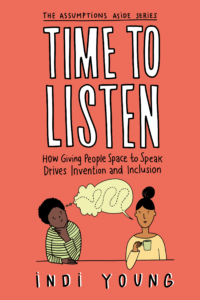
Local booksellers (ask your bookseller if they have access to the Ingram catalog)
Making time to listen is how we begin healing the broken relationship between businesses (& systems) and people.
Product design strategy often seeks to change a person’s buying decisions or to manipulate a person’s behavior. Such a product-focused mindset has driven our organizations into a corner. Even when product design teams want to benefit a person, they discover how they’ve harmed them instead by not recognizing their thinking and approaches.
Listening Deeply changes everything.
Preface – That Word “Listen”
Chapter 1 – What’s Wrong with Average
Chapter 2 – Listening to Build Knowledge
Chapter 3 – Assumption-wary Knowledge
Chapter 4 – Setting the Purpose
Chapter 5 – Recruiting for Listening Sessions
Chapter 6 – Inside the Listening Session
Chapter 7 – Ensuring a Safe Space
Chapter 8 – Handling Complexity Well
Chapter 9 – Next: Data Synthesis and Thinking Styles
Download Images
If you prefer:
Self-Paced Course: Listening Deeply
(Check if a Practice Group is scheduled.)
Testimonials
Reviews
Hiebing Book Club: Time To Listen, by Hiebing
Creative Differences Book Review: Time to Listen, by Donald Farmer
Thank You to My Production Team
Thank you to my production team who are brilliant, warm, truly changed the course of the book, and most of all, not rushed. They made it possible to write in a more inclusive manner, with a global audience in mind, as well as with accessibility foremost. They are such experts that the digital format works so well for screen-readers that even the examples in tables read out well!
Thank you most of all to Tanith Lovetree who designed the entire layout!
Anna Iurchenko – visual explanations
Zulaikha Rahman – foreword
Nathan Boole – editing & suggestions
Cecilia Gonzalez – marketing & social media
Alex Hughes – chapter one guidance & editing
Yousef Kazerooni – imprint design for Indi Young Books
Pam Mayer – sub-title
Stephanie Noble – series title
Steve Grieshaber – color-testing the cover
Svetlana Kouznetkova, Jane Hellendag, Charissa Ramirez – how to approach that word “listen”
Kunyi Mangalam, Bibiana Nunes, Andrea Villa, Cecilia Gonzalez – for gently redirecting my thinking
Anja Maerz, Augusto Bianchi, Bibiana Nunes, Cecilia Gonzalez, Francesca Barrientos, Gerry Wunsch, Jess Sand, Natalia Harzu, Pei Ling Chin, Yousef Kazerooni – reviewing chapters
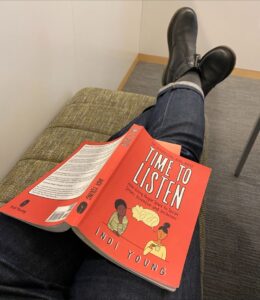
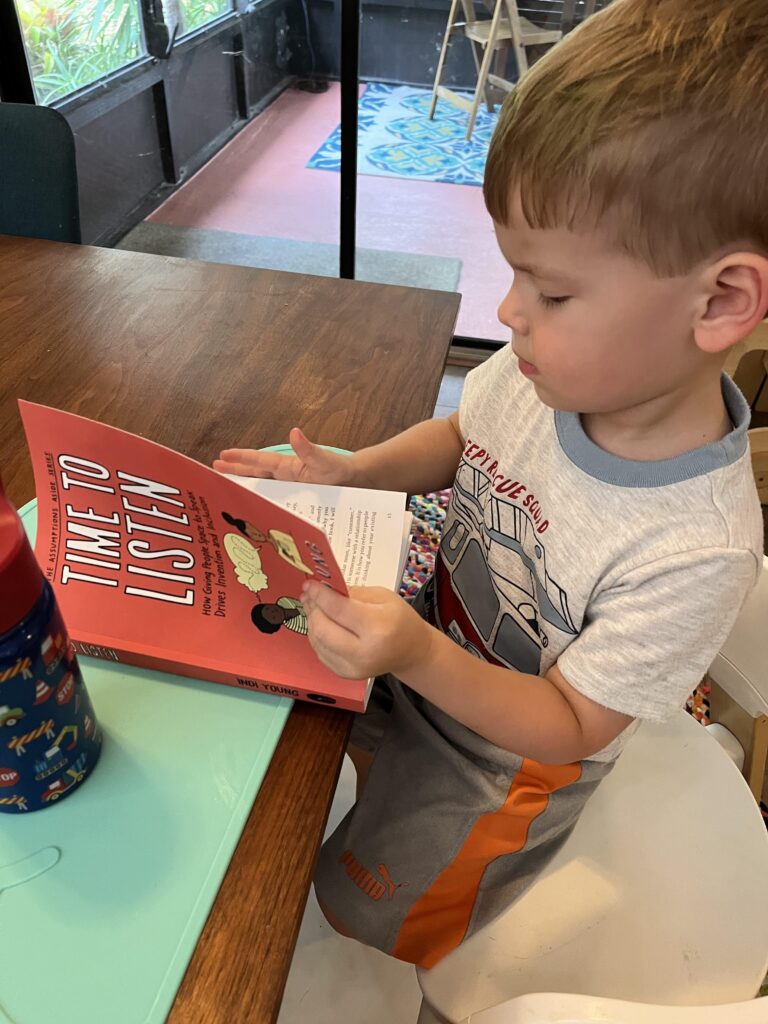

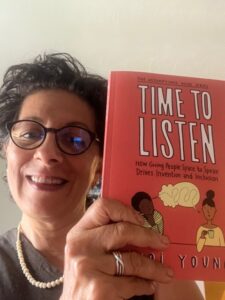
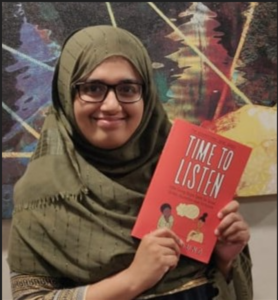


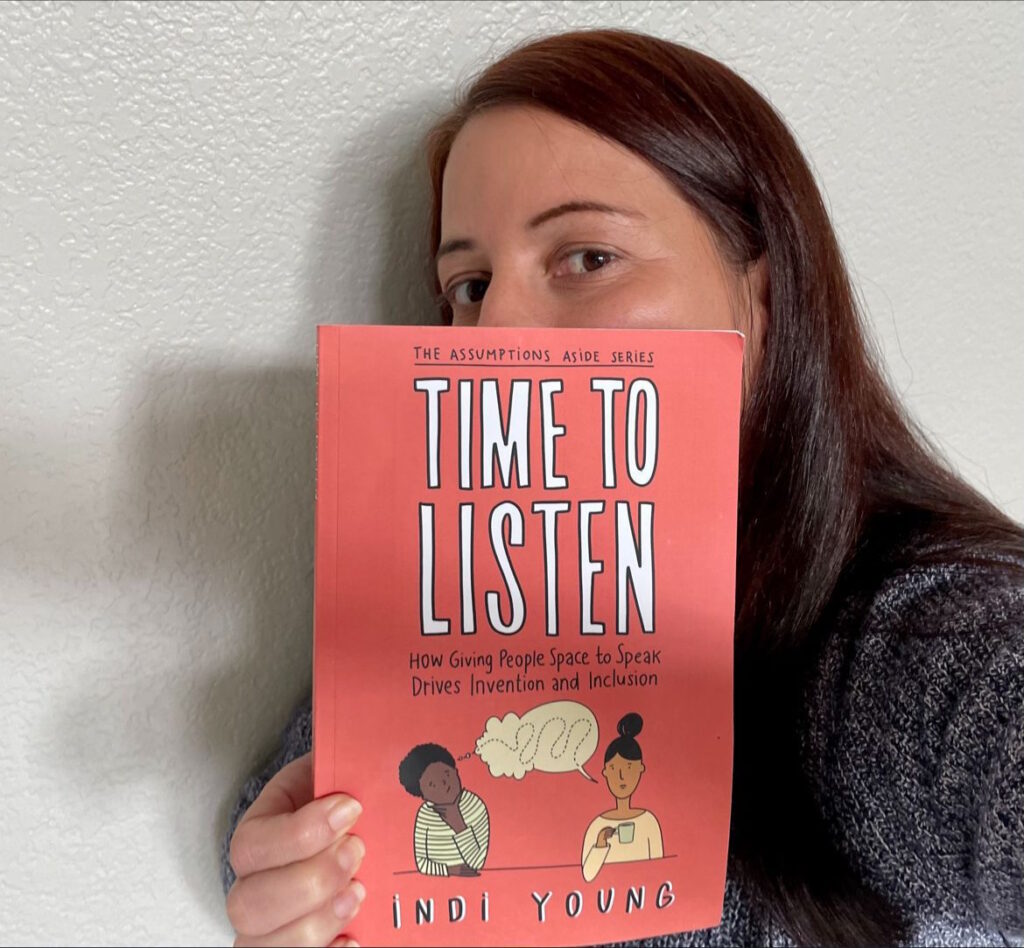

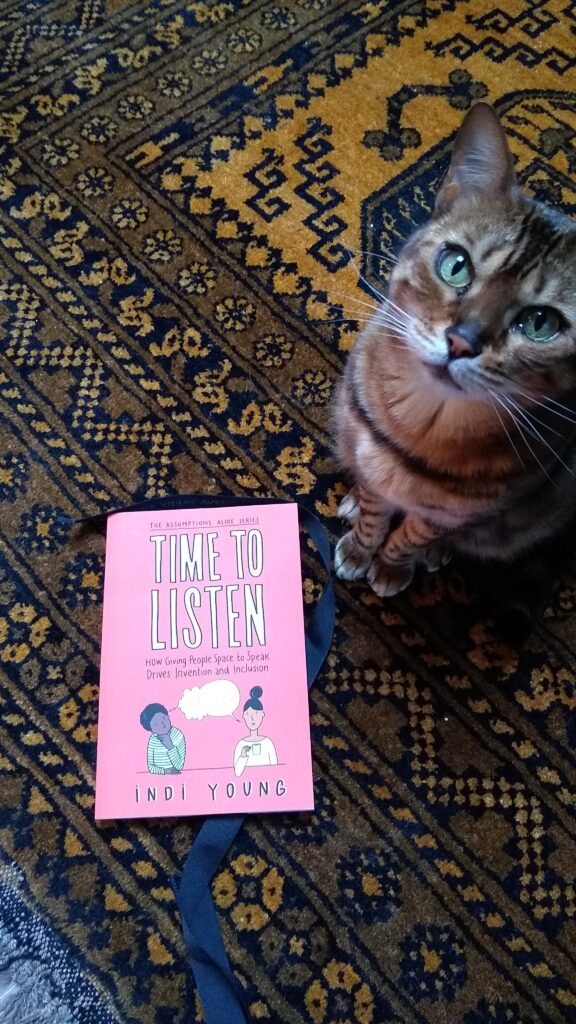


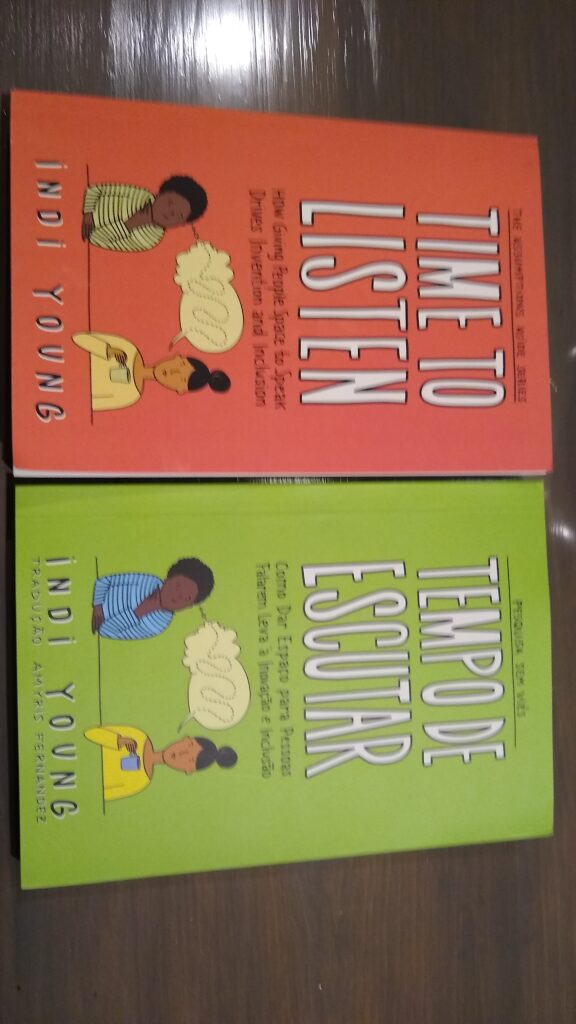

Conventional product development focuses on the solution. Empathy is a mindset that focuses on people, helping you to understand their thinking patterns and perspectives. Practical Empathy will show you how to gather and compare these patterns to make better decisions, improve your strategy, and collaborate successfully.
Chapter 1: Business Is Out of Balance
Chapter 2: Empathy Brings Balance
Chapter 3: Put Empathy to Work
Chapter 4: A New Way to Listen
Chapter 5: Make Sense of What You Heard
Chapter 6: Apply Empathy to What You Create
Chapter 7: Apply Empathy with People at Work
Chapter 8: Apply Empathy Within Your Organization
Chapter 9: Where Do You Go from Here?
In Chinese

Published by Tsinghua University Press
Testimonials
Customer Experience is now a key competitive differentiator; however, to truly stand out, organizations need to have and apply empathy for their customers.
This wonderfully insightful book teaches us why empathy is important, how to gain it, and how to apply it within our businesses.— Richard Dalton,
Understanding the ‘story of why’ is exactly the strategy we use to align our product roadmaps. Indi’s guide is clear and helpful, and shows how to develop empathy for users.
— Eric Fain,
Practical Empathy will convince designers and product managers how and why empathy is a key ingredient to both product innovation and organizational success.
— Sam Ladner,
As a designer, manager, husband, and parent, a lot of people will tell you that you should listen more, but few are able to show you how it’s done. Practical Empathy analyzes in great detail what kind of mindset leads to serious listening. If you do a lot of interviews,…
— Oliver Reichenstein,
Read more
Practical Empathy is a straightforward guide to extracting greater ROI from the squishiness of empathy.
— Harry Max,
Your product design should be informed by a deep understanding of user goals. In Practical Empathy, Indi outlines a way of working that goes beyond data-driven research methods to deliver genuine empathy for the people who use the things we make.
— Karen McGrane,
Reviews
Jane Sheppard, Using Practical Empathy to Improve Product Design and Collaboration, Udacity, August 17, 2016
Get creative with this inspiring new book, Creative Bloq, January 14, 2015
Preview: Rosenfeld Media book launch – Breaking Through the Empathy Gap, May 28, 2015 (audio)
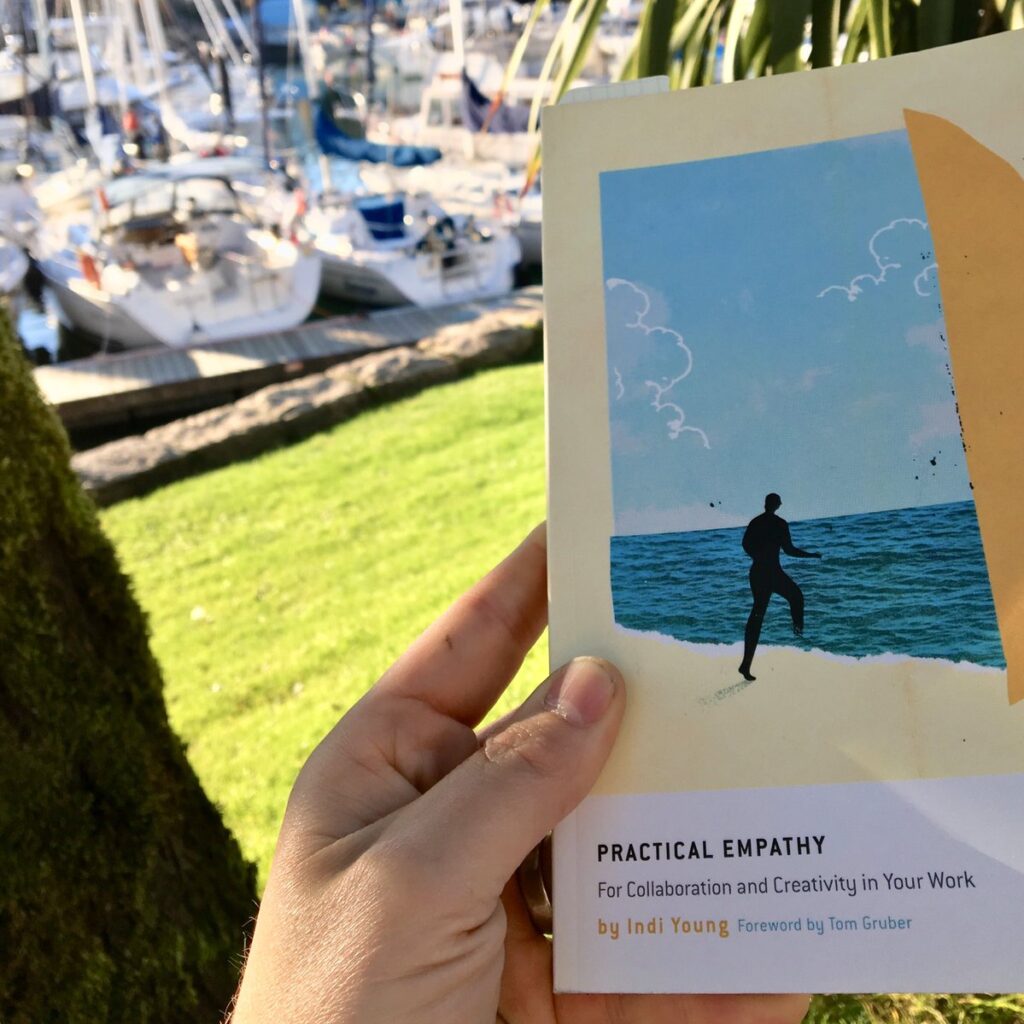
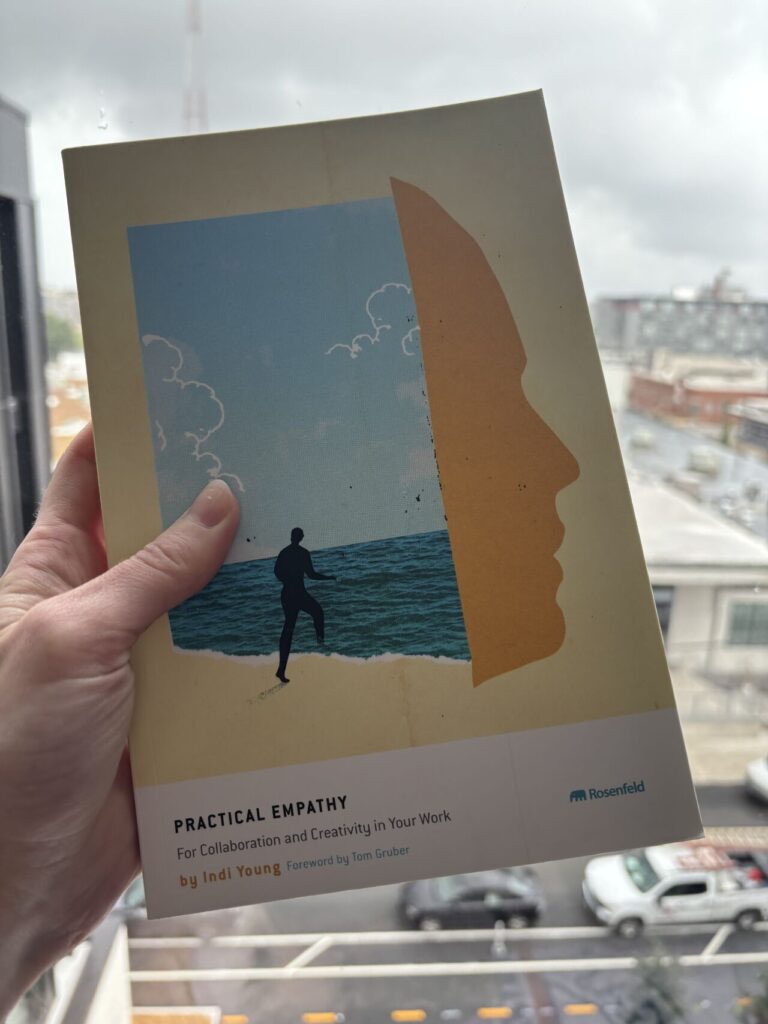

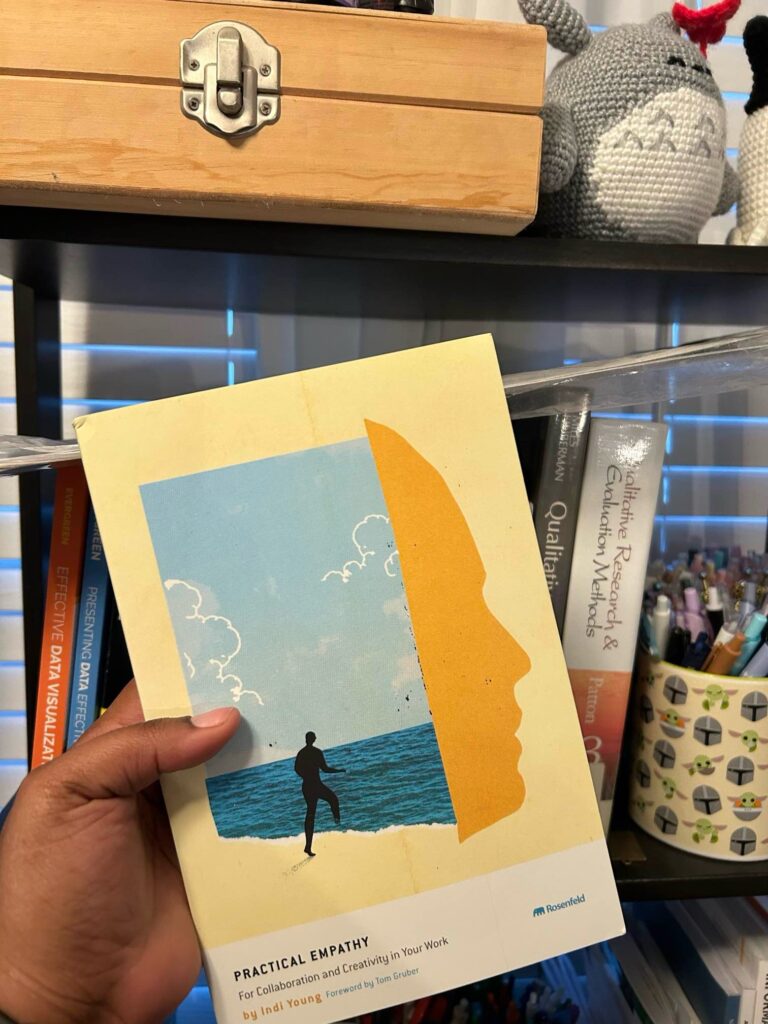
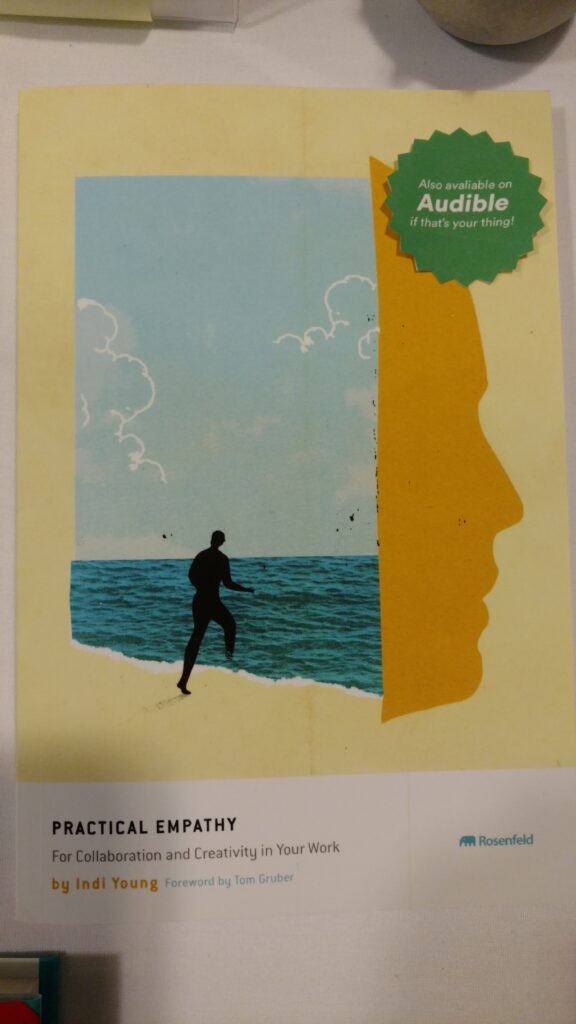
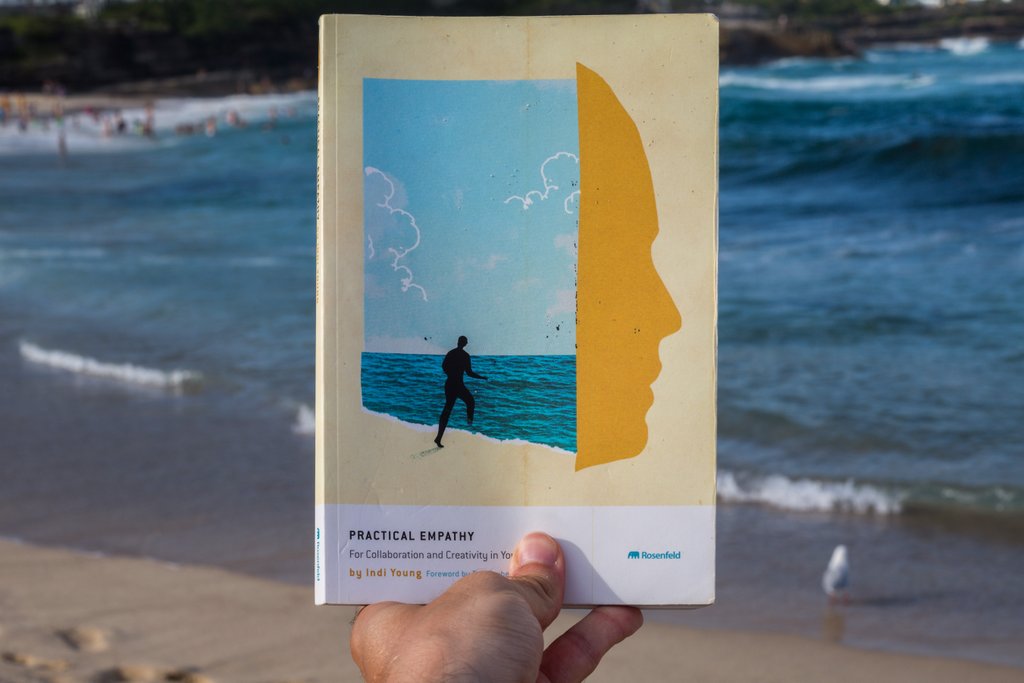

Note on terminology: This book uses the word “task,” which I abandoned after publication because of its many shades of meaning. In my later books the word shifted to “concept.”
There is no single methodology for creating the perfect product—but you can increase your odds. One of the best ways is to understand users’ reasons for doing things. Mental Models gives you the tools to help you grasp, and design for, those reasons. Indi Young has written a roll-up-your-sleeves book for designers, managers, and anyone else interested in making design strategic, and successful.
Chapter 1: What and Why? The Advantages of a Mental Model
Chapter 2: When? Using Mental Models with Your Other Work
Chapter 3: Who? Mental Model Team Participants
Chapter 4: Define Task-Based Audience Segments
Chapter 5: Specify Recruiting Details
Chapter 6: Set Scope for the Interviews
Chapter 7: Interview Participants
Chapter 8: Analyze the Transcripts
Chapter 9: Look for Patterns
Chapter 10: Create the Mental Model
Chapter 11: Adjust the Audience Segments
Chapter 12: Alignment and Gap Analysis
Chapter 13: Structure Derivation
Testimonials
Indi Young’s new book is a welcome addition, covering an aspect of the design process that is extremely important but often neglected. The book is chock-full of practical advice derived from real-world development projects, but doesn’t lose sight of the broad conceptual underpinnings.
— Ray Valdes,
Mental models reveal all those things that should be obvious during the design process, but so often come back to haunt you later. Indi’s book provides a systematic and invaluable means for applying mental models; having used her method on many large projects, I’m a true believer.
— Camille Sobalvarro,
Mental Models offers a practical set of techniques for task analysis in the early stage of design thinking and strategic design planning. Developed over the course of more than ten years, Indi Young’s common sense approach focuses on user behavior, diagrammatic representations, and the participation of all stakeholders in collaborative…
— Richard Buchanan,
Read more
At Dow Corning, Mental Models offer understanding at many levels—from a high level overview of customers’ generic unmet needs, to providing a detailed examination of the atomic tasks that they carry out as part of their jobs. So too for this indispensable book—it offers both a high level overview of…
— Simon Parker,
Read more
Reviews
Reena Jana, Tool: Mental Models, Business Week, November 26, 2006

